July 7 - 13, 2013: Issue 118
Barrenjoey Headland – The Lessees
During our first month of Summer Houses in December 2011 we brought you a tent at the Basin, a boarding House in the form of Scott’s Hotel or Bay View House at Newport, Bilgola Cottage at…Bilgola, and Woodley’s Cottage at the foot of Barrenjoey Headland, and Woodley’s Cottage; old Broken Bay Custom’s Station original home for the Boat Waiters stationed there.
In April 2013’s focus on Organisation’s on Water month of History pages Broken Bay Custom’s Station, and a little about those who worked there, gave further insights into the changing of the guards and times of this historical and iconic part of Sydney’s heritage.
This week we’d like to bring a few insights into some of those who have been fortunate to live in these structures since the Custom’s station closed and the lighthouse was no longer ‘manned’ by human beings.
The first lighthouse to begin casting its light to guide and guard all seafarers was the Macquarie at Sydney’s South Head 195 years ago this November:
This year marks the150th anniversary of the first lighthouse beam ever to shine upon Australian waters. On November 30,1818, in the days of Governor Lachlan Macquarie, the magnificent lighthouse at Sydney's South Head (it bears his name) gave the first of its thousands of nights of devoted service to sea-farers. Today, the Commonwealth Lighthouse Service, provided by the Department of Shipping and Transport, is responsible for no fewer than 294 lights and other navigation aids on the Australian coast, and 125 on the coastline of Papua New Guinea. 600 PRIZES: Bursaries, sea cruises, books, TV, radio. (1968, December 4). The Australian Women's Weekly (1933 - 1982), p. 44. Retrieved from http://nla.gov.au/nla.news-article51393854
Barrenjoey Lighthouse was the third light on the headlands near Sydney and was completed in 1881. With the closing of the Customs Station in 1900 many new uses for the headland were raised and then faded. One of these rumours;
NAVAL COLLEGE SITE. SYDNEY. June 25.
My report respecting suitable sites for the Commonwealth Naval College was forwarded to the Federal Government on Saturday,' said Capt. Bertram Chambers, R.N., today, and I am hoping that we shall soon be able to' make a start. I saw three or four sites which I greatly admired. One just a little to the north of Sydney impressed me. Of course, there are others.' There is every reason to believe that the site he has in view is that of Barrenjoey. This, appears to fulfill all the requirements spoken of by Capt. Chambers on his arrival in Sydney early this month. Barrenjoey is the headland at the entrance to Broken Bay, into which the Hawkesbury River flows, and is about 19 miles north of the Sydney Heads. NAVAL COLLEGE SITE. (1911, June 26). The Register(Adelaide, SA : 1901 - 1929), p. 7. Retrieved from http://nla.gov.au/nla.news-article59039495
In July 1915 the Commonwealth took responsibility for 179 marine marks including 104 manned stations of which Barrenjoey was one, although State and Commonwealth bickering meant that it was not taken over until 1927. In 1931 as part of the use of Broken Bay as a live aerial bombing exercise range, bombing signals were installed at the lighthouse which were monitored by the Keepers. The lighthouse boatsheds were used for storage of the target floats and equipment.
Due to the prolonged negotiations over the transfer of the lighthouse from State to Commonwealth control, Brewis’s recommendations were not implemented at Barrenjoey until 1932. In that year the light was converted to the group flashing automatic light. The automation made the Keepers jobs redundant and the last two, Fred Warren and John Berryman and their families left the site, leaving the cottages unoccupied. Since its opening in 1881, 21 Keepers and families had lived on site at Barrenjoey (1.)
Barrenjoey Headland has been in our consciousness for so long, with so many enjoying the spectacular views and sense of history you get when walking there, that everyone has long held a part ownership:
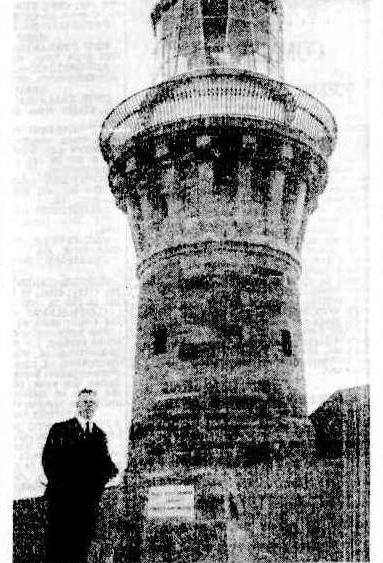 BARRENJOEY OR GLEDHILL? TO THE EDITOR OF THE HERALD.
BARRENJOEY OR GLEDHILL? TO THE EDITOR OF THE HERALD.
Sir,- It is time that someone sent forth a clarion call to acquaint the people of Sydney and Australia of what is happening at Barrenjoey Head, where for many years a red light has been one of the most prominent guiding lights on the coastline.
The name Barrenjoey, I understand, is to be changed on Saturday, July 13, to Gledhill Lookout. Why is this being done? This, surely, is wrong. Barrenjoey is a national name, which ninety-nine and seven-eights per cent, of the people of Sydney would retain, did they but know what the Common- wealth Government is permitting to be done, on one of the nearer northern headlands. Captain Cook ordered that the name Broken Bay be given to low-lying land, which he took to be a bay. Just who named the headland in question Barrenjoey I am not able to say. But whoever did the naming chose one that is full of sweetness and music, and should not be exchanged for anybody's lookout. The well-known names Turimetta, Bungan, Long Reef, Deewhy, Manly, Pinchgut, and Goat Island must remain. And so should Barrenjoey.
I am, etc,
CUNJEBOY
Sydney, July 3.
BARRENJOEY OR GLEDHILL?. (1935, July 4). The Sydney Morning Herald (NSW : 1842 - 1954), p. 6. Retrieved from http://nla.gov.au/nla.news-article17206588
RIGHT: Mr . P. W. Gledhill standing beside the cairn he has erected at Gledhill Lookout, which was unveiled yesterday. The Barrenjoey lighthouse is in the background. RUSHING WATERS CHURNED INTO WHITE FOAM AT HUME DAM — PASSENGER AEROPLANE CRASHES AT MASCOT. (1936, November 23). The Sydney Morning Herald (NSW : 1842 - 1954), p. 12. Retrieved from http://nla.gov.au/nla.news-article17284781
In September 1937 a Barrenjoey Headland lease was advertised by the Commonwealth Government just twice. A syndicate, whose spokesman was one F. J. Terry, quickly secured a 50 year lease and then pursued bigger plans:
A syndicate has applied to the Lands Department for a lease of 12 acres of Crown land on Barrenjoey Peninsula, stating that it has already secured a lease from the Federal Government of land in the lighthouse Reserve. It is reported that the syndicate proposes, to spend £100,000 in erecting cabins, parking enclosures, and recreation areas for holiday-makers The proposal is being strongly opposed by owners of property at Palm Beach. HOME NEWS. (1938, August 2). The Sydney Morning Herald(NSW : 1842 - 1954), p. 1. Retrieved from http://nla.gov.au/nla.news-article17483345
BARRENJOEY PROJECT Opposing Views At Palm Beach
Palm Beach opinion Is sharply-divided as to the results of the reported lease of Barrenjoey Headland; to an American syndicate. It is said that the Federal Government has already granted the lease, and that the syndicate will spend £200,000 on cabins for holiday-makers. "That expenditure should be very welcome to Palm Beach, provided, of course, that it Is spent In a way approved by the authorities," declared the chairman of Palm Beach Lands, Ltd. (Mr. R. J. McKay), today. "Transport and sporting facilities would probably be Improved. I don't think it would depreciate land values. This, however, Is the opinion only of myself and the firm I represent." "We don't like It at any price," said Mrs. S. B. Hooper, secretary of Palm Beach Progress Association. Land values, she added, would slump Immediately, and Palm Beach would become a commercialised business place, losing all the natural beauty and isolation that has made it an attractive holiday resort. BARRENJOEY PROJECT (1938, August 1). The Sun (Sydney, NSW : 1910 - 1954), p. 3 (LATE FINAL EXTRA). Retrieved from http://nla.gov.au/nla.news-article229128008
PALM BEACH Council Is Against Any Lease
SYDNEY, Wednesday Warringah Shire Council last night resolved to ask the Minister for Lands, Mr. Sinclair, to reject the application by Mr.F. J. Terry e leassee of Barrenjoey Headland for a lease of 12 acres of Crown land reserve adjoining, through which he desires to provide access to the headlandl from the Palm Beach Road.
Mr: Terry , who has leased the land from the Department of the Interior, said yesterday that it was proposed to erect, not holiday cabins, but substantial improvements for residential and entertainment purposes. The lease of 70 acres, covering the whole of the headland except for some small areas around the lighthouse and the memorial cairn, was for 50 years, and subject to stringent conditions, which he had assured the department would be carried out.
Mr. Terry added that he held the lease personally. It had been granted after the area had been advertised for leasing in September last year. PALM BEACH (1938, August 3). Goulburn Evening Penny Post (NSW : 1881 - 1940), p. 7 (Daily). Retrieved from http://nla.gov.au/nla.news-article102418792
BARRENJOEY LEASE. Inquiry Probable.
An inquiry will probably be held by the Metropolitan Land Board into the application by Mr. F. J. Terry for a lease of 12 acres of Crown land reserve adjoining the Barrenjoey headland. Mr. Terry, who has leased the greater part of the headland from the Federal Government, desires the new lease in order to give access to the headland from the Palm Beach Road. The inquiry may not be held for sometime. The matter will not be considered at the board's next sitting on August 23and future sittings are fixed by the chair-man. The Minister for Lands has power to approve a lease, but rarely exercises it, except where his approval is purely formal. Where objections have been raised, as in this instance, an inquiry is usual.
Captain M. J. Lowe, president of the Manly, Warringah, and Pittwater Historical Society, said yesterday that his members had an interest in Barrenjoey Peninsula, because of the historical memorials ejected there. They had received an assurance from Mr. Terry that these would be protected and cared for. Apart from these memorials, the society had no reason for concern.
"We are not likely to stand in the way of progress or development," Captain Lowe said.
On the headland is an obelisk marking the site of the first Barrenjoey lighthouse, and alongside the present light is the Gledhill Lookout. On the sand spit, adjacent to Governor Phillip Park, is a cairn commemorating the naming of Pittwater by Phillip on March 3 1788.
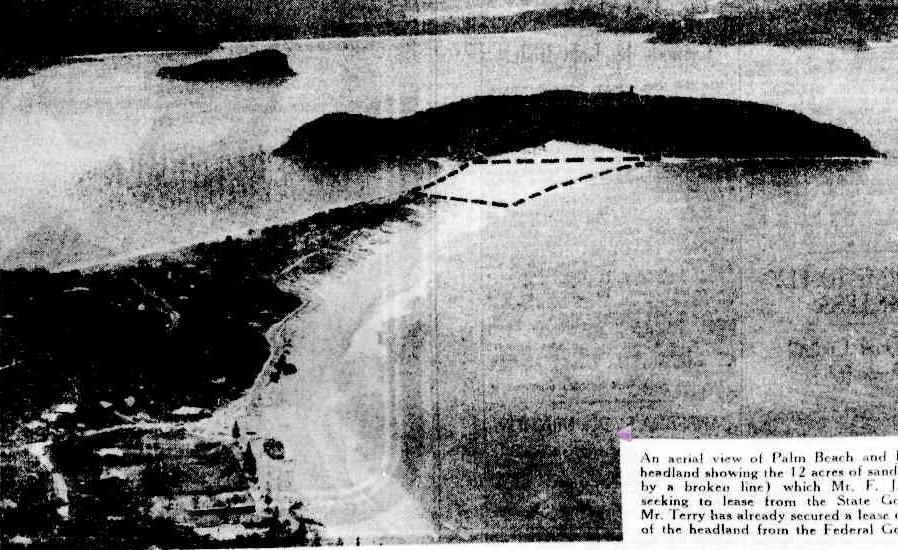
An aerial view of Palm Beach and Barrenjoey headland showing the 12 acres of sand (enclosed by a broken line) which Mr. F. J. Terry is seeking to lease from the State Government. Mr. Terry has already secured a lease of 70 acres of the headland from the Federal Government. Copies of pictures by "Sydney Morning Herald" photographers may be purchased from the Art Gallery at the "Herald" Office. Scale of charges may be obtained on application. BARRENJOEY LEASE. (1938, August 4). The Sydney Morning Herald (NSW : 1842 - 1954), p. 11. Retrieved fromhttp://nla.gov.au/nla.news-article17489009
BARRENJOEY HEAD. Council Against Access. LESSEE DEFENDS SCHEME.,
Warringah Shire Council last night resolved lo ask the Minister for Lands Mr Sinclair to reject the application of Mr Terry leasee of Barrenjoey Headland for a lease of 12 acres of Crown land reserve adjoining through which he desires to provide access to the headland from the Palm Beach Road. Mr Terry who has leased the area from the Department of the Interior said yesterday that it was proposed to erect not holiday cabins but substantial improvements for residential and entertainment purposes. The lease of 70 acres covering the whole of the headland except some small areas round the lighthouse and the memorial cairn was for 50 years and subject to stringent conditions which he had assured the department would be carried out.
Mr Terry added that he held the lease personally. It had been granted after the area had been advertised for leasing in September of last year. To make the use of it he proposed it was necessary to get access to it from the main road leading to Palm Beach. He had made application to the State Lands Department for a lease for a period of 28 years of 12 acres of the Crown Lands Reserve south of the headland. The area applied for was a barren wind swept sand dune.
Financial organizations it is understood are interested in the proposal which involves expenditure of upward of £100 000.
The matter was brought under the notice of the Council by the acting metropolitan district surveyor Mr. Max Allen who said that the purpose of the application in desiring a lease of the land was to use it for recreation and parking. Mi Terry had supported his application by representing that the area was required in conjunction with the Barrenjoey Headland which he had leased from the Commonwealth Government and that a comprehensive scheme for improvement was contemplated.
The council was asked to advise the Land Board if they objected to the granting of Mr. Terry's application.
There was also a letter from Mr. P C Spender MP who said he was definitely opposed to any amusement area week-end camps on Barrenjoey Headland and was protesting to the Federal Government on the matter.
Councilor Campbell said that if the lease was granted by the Lands Department, the land might never come back to the council. It would be against the public interest to hand it over to private enterprise. Councilor Latham asked the council to allow the matter to stand over until details of the other lease were obtained from the Federal Government. This was defeated in favour of a motion by Alderman Campbell to oppose the granting of the lease. The Council had previously forwarded a protest to the Federal Government against the leasing of the Barrenjoey Headland for the purposes of private enterprise. BARRENJOEY HEAD. (1938, August 3). The Sydney Morning Herald (NSW : 1842 - 1954), p. 16. Retrieved from http://nla.gov.au/nla.news-article17495840
BARRENJOEY LEASE. Defence Interests Have Been Safeguarded.
The Minister for Defence, Mr. Thorby, said yesterday that the lease of Commonwealth land granted to Mr F. J Terry on Barrenjoey headland, wassubject to the right of the Commonwealth to re-occupy the land at any time if it was needed for defence purposes. The land Mr. Thorby said, had not been all a Defence reserve but the Defence Department had been consulted when it was proposed to lease it. and had raised no objection. After tenders hand been called by two announcements in the Commonwealth Gazette, the land excluding 10 short tenancies which had been granted previously, had been leased to Mr Terry for 50 years, from June 1 last, for the purpose of establishing a tourist resort. BARRENJOEY LEASE. (1938, August 5). The Sydney Morning Herald (NSW : 1842 - 1954), p. 11. Retrieved from http://nla.gov.au/nla.news-article17493285
BARRENJOEY LEASE. Proposed Buildings. MR. SPENDER, M.P., SEEKS INFORMATION.
The Assistant Minister for the Interior, Mr. Thompson, in a letter to Mr. Spender,M.P., stated that tenders for the lease of about 70 acres of land at Barrenjoey had closed on April 4. Mr. F. J Terry, the successful tenderer, had intimated that he proposed to establish a holiday recreation and entertainment area with club facilities and attractions. Mr. Thompson added that the Commonwealth was committed to lease the area to Mr. Terry. It was considered, however, that the proposed conditions of the lease would reasonably safeguard the interests of the public. Mr Spender, in a letter to the Minister, directed attention to the condition of the lease which required, apparently, that the sanction of the Commonwealth must be obtained before any buildings were erected. He asked the Minister for information about the type of building and facilities which the department would permit, and suggested that before approval was given the advice of the Warringah Shire Council should be sought.BARRENJOEY LEASE. (1938, August 13). The Sydney Morning Herald (NSW : 1842 - 1954), p. 16. Retrieved from http://nla.gov.au/nla.news-article17488203
BARRENJOEY LEASE. Opposition by Parks Movement. The committee of the Parks and Playground Movement: BARRENJOEY LEASE. (1938, September 22). The Sydney Morning Herald (NSW : 1842 - 1954), p. 13. Retrieved from http://nla.gov.au/nla.news-article17521106
BARRENJOEY LAND. Minister Refuses Lease. 20 ACRES OF PUBLIC RESERVE.
The Minister for Lands, Mr. Sinclair, has refused the application by Mr. F. J. Terry for a lease of 20 acres of public reserve adjoining land on Barrenjoey headland already leased to Mr Terry by the Commonwealth. Mr. Terry said yesterday that he was negotiating with the Warringah Shire Council for the making of a road to the headland as shown on a sketch map attached to the lease from the Commonwealth Government. On the plan the road is shown running through the park area on the Pittwater side where the golf links are located. Mr Terry stated that he believed that the Minister had refused his application without being aware of all the circumstances, and he intended to re-apply for a lease of 20 acres of what he described as the sand dunes. The Warringah Shire Council which opposed the granting of the lease will discuss the matter again at Its meeting tonight. BARRENJOEY LAND. (1938, September 27). The Sydney Morning Herald (NSW : 1842 - 1954), p. 11. Retrieved from http://nla.gov.au/nla.news-article17522639
Undaunted, Mr Terry pursued his, or his syndicates, agenda:
SURVEYOR FALLS OVER CLIFF. Lucky Rescue When Tossed On Ledge By Wave SYDNEY, December 13.
Mr. W. C. Duffy, 52, of the survey branch of the Department of the Interior, received serious injuries to his spine today when he fell several feet over a cliff into the sea near the Barrenjoey lighthouse and was tossed about in the breakers until a wave hurled him back on to a ledge of rack. Mr. Duffy was engaged with several others on survey work near the lighthouse when he slipped. His rescue seemed a hopeless task until a wave lifted him back to the rocks. He was then unconscious. An improvised stretcher was made by fixing bags to two poles and on this Mr. Duffy was carried about: a mile over rocks and up a dangerous track to a wharf not far from the lighthouse., As Saturday's hurricane had broken all the telephone lines in the district, a messenger had to go four miles to telephone the Manly ambulance. This meant a delay of nearly two hours. There was no road to the wharf, and the ambulance wagon had to be left nearly a mile from where Mr. Duffy was lying. SURVEYOR FALLS OVER CLIFF. (1938, December 14). The Advertiser(Adelaide, SA : 1931 - 1954), p. 27. Retrieved from http://nla.gov.au/nla.news-article36600416
From Warrigah Shire Council minutes of Meetings;
6o. F.J.Terry, 26/4/39, submitting proposal for the leasing for a period of 15 years, of the Whole of the area of about 50 acres at Palm Beach adjoining his lease at Barrenjoey, and Peninsula including the golf links. "Received' (era. Sterland, Lands Hitchcock) An amendment moved by Cr. Butcher, seconded by Cr. Campbell, that consideration be.deferred until after the Special Meeting was lost. From Warringah Shire Council Minutes.
37. Palm Beach Progress Assoc., 27/9/39, stating it is understood the proposed lease of Barrenjoey Reserve to Mr. Terry has not yet been completed, and suggesting that a further protest be submitted against the granting of the lease. Resolved - That a further protest be made to the Federal authorities, as requested. (Crs. Hitchcock, Savage)
47. F. J. Terry, 15/12/39, requesting permission to carry a water pipe line from the main through Governor Phillip Park to-his property at Barrenjoey. Resolved, - That permission be granted, subject to the Engineer’s approval.
F. Terry, 3/1/40, forwarding plan showing proposed road along the foreshores of Barrenjoey, and indicating the water pipe line from Beach Road to Barrenjoey. Referred to the Works Committee for report.
In 1940 the headland became an essential part of Sydney’s defence in WWII and under the Dept. Of Defence. All claims on these lands would have been cancelled. No more about what happened to Mr Terry’s 50 year lease can be found at this stage.
In 1945 the son of artist George Finey, Bruen born in Manly in 1924, returning from service, spent time at Palm Beach and fell in love with the surrounds. Some state he and other artists, including Avalon artist Arthur Murch, began using the structures from 1946;
Pictures by staff photographer Ron Berg.
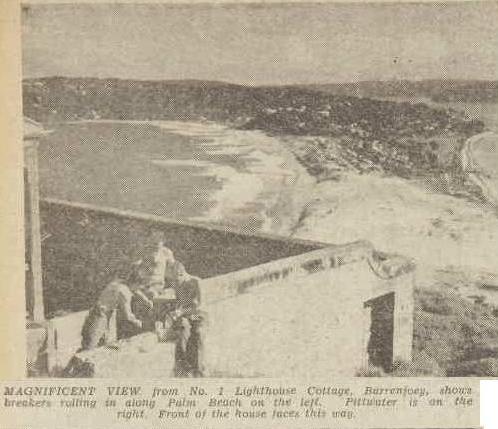 A spirit of adventure and plenty of enterprise have enabled a 26-year-old Sydney sculpture student to solve housing and studio problems by leasing a lighthouse-keepers' abandoned cottage for 5/- a week. The student is Bruen Finey, son of well-known artist George Finey. The house is a six-roomed cottage at Barrenjoey, Palm Beach, N.S.W. For years it has been ravaged by rats during the week and vandals at week-ends.
A spirit of adventure and plenty of enterprise have enabled a 26-year-old Sydney sculpture student to solve housing and studio problems by leasing a lighthouse-keepers' abandoned cottage for 5/- a week. The student is Bruen Finey, son of well-known artist George Finey. The house is a six-roomed cottage at Barrenjoey, Palm Beach, N.S.W. For years it has been ravaged by rats during the week and vandals at week-ends.
ALL that is left of the once snug dwelling is a stone shell with an iron roof.
Bruen, who is at East Sydney Technical College under the Commonwealth Reconstruction Training Scheme, is in his last term and wants somewhere to live and work. He has found in some fellow students equally ardent spirits, who will share the back-breaking job of making the house comfortable and form the nucleus of a small community with the arts as their great common interest.
The idea of taking the house first came to him when he was spending a day at Palm Beach in 1947. Enchanted by the position, more than 300 feet above the Pacific, with a magnificent view in all directions, Bruen was ready to tackle anything to make it his home. His first step was to find out which Government department controlled the house. It proved to be the Department of the Interior.
Barrenjoey headland, once the 400-acre farm of Larkfield, granted to an early settler in 1816, is now Commonwealth land reserved for use by the Army when it is required for defence, but at present administered by the Department.
Young Finey immediately applied for a lease, but it was not until January, 1949, that the transaction was complete, and Bruen received his passport to paradise-an official letter notifying him that he had a five years' lease of No. 1 House, Barrenjoey. Since then he has sweated and toiled week-end by week-end to make the house habitable. To make it so you would need what Bruen has-youth, enthusiasm, an undaunted spirit, and plenty of muscular strength-or a bottomless purse.
From the water's edge he and his friends carry on their shoulders every piece of material used. The only road is a narrow, steep track, strewn with big boulders and cut by deep gutters. It would be impassable for any vehicle except a jeep with a four wheel drive, or a horse and dray, such as the former Lighthouse keepers' furniture was brought in. One glorious day, with the pleasure-seeking Palm Beach week-end crowd forming a background to the hard slogging of the Barrenjoey boys. I joined the working party. David Hain and John Giles, two other members of the group, were with Bruen.
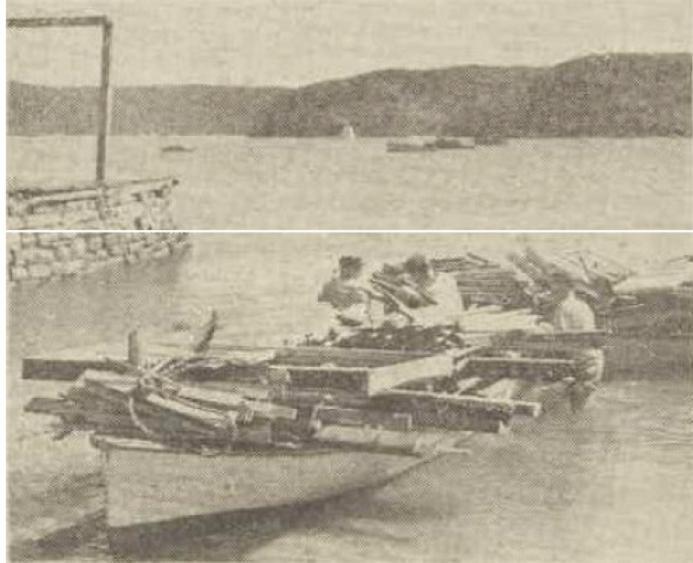 WADING waist-deep into the water, boys bring ashore two launches laden with materials for repairs. Old jetty was once busy scene when Broken Bay was port.
WADING waist-deep into the water, boys bring ashore two launches laden with materials for repairs. Old jetty was once busy scene when Broken Bay was port.
First scene of operations was alongside the golf links. Each lad in turn trundled a barrow, laden with materials, from the roadway to a nearby beach, where two launches were loaded to the Plimsoll line.
Cargo varied from huge doors to chair legs, and included an iron bedstead. It was a job lot the new tenants had picked up from a city hospital, and it had been stripped from an outpatients' section.
Working hard in the sun, the boys aroused the interest and sympathy of Mrs. E. Silverton, who brought from her home beer and biscuits to give them fresh heart.
It was a gesture you would expect from Mrs. Silverton, who remarked: "Well, dear, what I say is a little kindness never hurts you and I can't tell you all the happiness that has come to me because
I've been kind to people."
When I asked Mrs. Silverton how I would address something she asked me to send her she replied: "Just sent it to 'Auntie, Palm Beach.' Everyone here knows me.
"Auntie"' Silverton has a special interest in Barrenjoey, for the house next to Bruen's was once her home. She came from New Zealand, and brought with her some beautiful furniture made of a prized New Zealand wood. Mrs. Silverton and a friend used0 run a tea-room in the house, but they were driven out by snakes, although the business brought in £5 a week.
Snakes have not daunted them, David has already stood on two.
When they were fully loaded the launches chugged off down the bay; io the beach at the foot of Barrenjoey Headland. Bruen stores all his materials in a roomy, ramshackle boatshed near, the old jetty on the Pittwater side.
"Every time we climb to the top we carry something," he said.
First job Bruen did was to fill in the great windows from which even the frames had been taken, and to make a strong door for at least one room so that tools and materials would not "go off."
As everything is on the spacious scale of last century, the shutters for each window measure seven feet by three. That means a lot of carrying and a lot of carpentering. The shutters will be painted yellowand the wooden posts around the long stone-paved verandahs white.
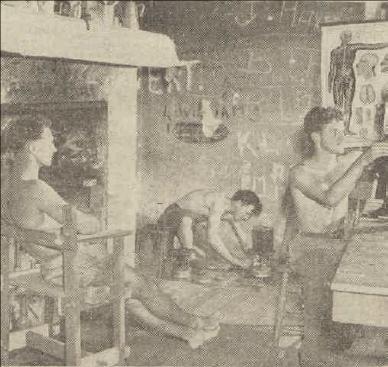 Picture left: HOMEMADE FURNITURE in the kitchen is the work of Bruen. Although primitive, it is solid. Defaced walls are typical of the vandalism in the old house, but the boys are confident that they will restore it in time. Each will have a room to himself.
Picture left: HOMEMADE FURNITURE in the kitchen is the work of Bruen. Although primitive, it is solid. Defaced walls are typical of the vandalism in the old house, but the boys are confident that they will restore it in time. Each will have a room to himself.
Big rooms
On the first floor, which is the level on which the house is entered, are six beautiful big rooms, each with its own fireplace, and a fines hallway, 33 feet long and six feet wide. Old sandstone steps, worn into hollows in the centre, lead down to the kitchen and bathroom, on the floor below. So far the bathroom is still a shambles, and the bath is still on the beach.
Opening from the kitchen is the courtyard, surrounded by a 12ft. wall of solid stone, where the boys “hope to have a vegetable garden," sheltered from the winds that sweep around the solid old house. In this courtyard is a huge well, more than 15ft. deep, which was filled with junk when the boys took over. They had to siphon out the water, then climb in, and remove; all the oddments that had been- thrown in, including galvanised iron pipes and bedsteads.
An eager volunteer loader and unloader on the day of my visit was John Arblaster, grandson of one of the lighthouse-keepers. She recalls settling into the fine six-roomed house. All her furniture, brought from Newcastle, where her husband had been stationed, was landed on the jetty, and taken by horse-drawn lorry up the steep slope.
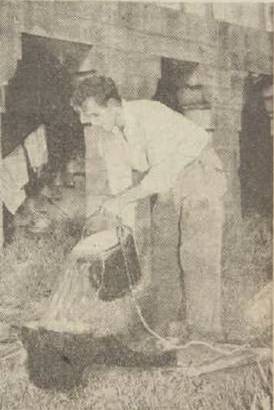 Picture right: WATER SUPPLY for No. 1 House, Barrenjoey, is a huge underground well in the courtyard. David Hain lowers one bucket, fills it, and then pours it into a second one.
Picture right: WATER SUPPLY for No. 1 House, Barrenjoey, is a huge underground well in the courtyard. David Hain lowers one bucket, fills it, and then pours it into a second one.
There was a light on the headland as early as 1855, but it was only lit in rough weather. The first permanent light was established in1868, at a cost of £300 for the tower and £85 for the light. In 1880 the foundation stone was laid of the present splendid tower, which is 38 feet high, and whose beam can be seen 25 miles at sea. It gives four flashes every 20 seconds.
The last of the keepers left the house in 1932, when the present unattended light first operated. In the lighthouse visitors' book there is this rather wistful record: "On the night of 13th August, 1932, no person was on the station for the first time since the light was established in 1868."
Bruen showed us, near his house, the gravestone of George Mulhall, who died at his lighthouse job in1881. His grave bears this message: "All ye that come my grave to see, Prepare in time to follow me, Repent at once without delay, For I in haste was called away."
The jetty, with its solid stone base and old loading gear, is a reminder that from 1843 until 1900 this quiet little spot was the landing stage for a customs house, used as long as Broken Bay ranked as a port.
There is a firm belief among the residents' of Barrenjoey headland that the first big thefts from Bruen's house took place overnight in a well organised raid. One theory is that the thieves lowered their loot on ropes from the cliff to a great flat rock below, where it is possible for a sea-going boat to pull alongside. The thieves left all the nails in neat piles when they stripped it of fixtures.
To the fishermen and their families who live in the shelter of the great cliff, the activities of the Barrenjoey Boys are a source of much interest.
Said Bruen, standing on the huge stone wall of his courtyard, and looking round: "There's only one trouble here-you're working away at some job or other, and you lookup, get lost in a dream, just looking, and looking, and before you know where you are you've wasted ages."
But I doubt if Bruen regards that time as really wasted.
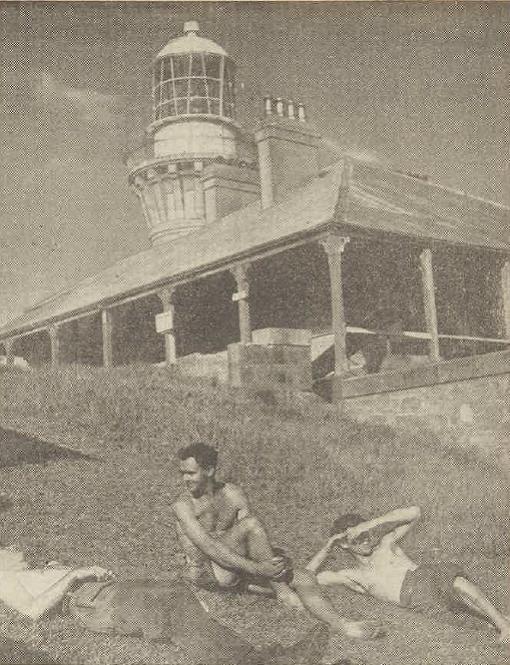 Picture left: WELL-EARNED REST for David Hain, Bruen Finey, and John Giles after carrying materials from the beach to the house they are making livable. It had been stripped by vandals.
Picture left: WELL-EARNED REST for David Hain, Bruen Finey, and John Giles after carrying materials from the beach to the house they are making livable. It had been stripped by vandals.
Old lighthouse cottage now sculptor's studio. (1950, May 20).The Australian Women's Weekly (1933 - 1982), p. 32. Retrieved from http://nla.gov.au/nla.news-article46455535
Bruen Finey seems to have given away sculpture and is well known for making surfboards for Dunlop as well as more boards through is own business ‘Crest Surfboards':
Bruen left the army after 1945 and studied sculpture, funded by an ex-war service grant, and took up working with fibreglass and foam in the 1950s, building chemical vats and shop displays, based in Brookvale where land was cheap and other fibreglass companies were located. He recalled sourcing polyurethane chemicals from a sugar refining company in Waterloo, but couldn’t remember the name. His contract with Dunlop to supply large numbers of boards every week meant hiring itinerant shapers, finishers and polishers. Bruen did all the glassing himself. ‘When the surf was up, no one wanted to work’. Profit was small and output of boards was slow so he decided to develop standard molds and ‘pop-out’ a generic shape. Not surprisingly, this proved a flop as surfers were a ‘fussy breed’ and wanted unique features and characteristics – so decided to sell business to Dunlop, who moved the board making operation to St Mary’s, far from the surf.
Working in Brookvale, on the northern beaches, Bruen remembers Scott Dillon, who sometimes sold him resin, Gordon Woods, a hard working scruffy bloke, Greg McDonagh, who built beautiful boards with clear resin over faultless foam and, or course, Barry Bennett. Bruen rode a large board he made himself although didn’t hang around with surfers who were a ‘close clique’ and didn’t take kindly to outsiders. He mostly surfed around Manly and could take off 40-50 feet outside everyone else and run through the crowd like a tanker. No wonder they cursed him. Big thanks to Bruen for the info and support. Written by Gary Crockett, June 20th, 2011 and retrieved from: http://blogs.hht.net.au/surfcity/?p=2044
DEPARTMENT OF THE INTERIOR LEASE OF COTTAGES NOS 2 and 3 AT BARRENJOEY. Offers closing with the Chief Property Officer Department of the Interior 5 Hickson Road Millers Point at noon on the 1st September 1952 are invited for the lease of the old Lighthouse Cottages Nos 2 and 3 at Barrenjoey for a period of 5 years with an option of renewal. The lease Is terminable at one month s notice without compensation should the premises be required for Commonwealth purposes and subject to the usual conditions Including Insurance of premises and past rent of oil rates and taxes etc by the lessee. The premises ore to be let as they stand and no expense In connection with renovation or repair will be borne by the commonwealth. No offer necessarily accepted WS KENT HUGHES Minister for the Interior . Advertising. (1952, August 23). The Sydney Morning Herald(NSW : 1842 - 1954), p. 17. Retrieved from http://nla.gov.au/nla.news-article18278568
From 1968 until 1999 popular local gentleman Jervis Sparks leased Cottage 2 at Barrenjoey Lighthouse. When it took over the building was again in a vandalised state and took many years for him to restore to 1800’s authenticity. He married Bridget, his wife, in 1974 on the Headland and is the author of Tales From Barranjoey, the first of a few volumes of wonderful histories his surrounds inspired.
Sparks was forced to vacate when the management of all Australian lightstations (now all automatic and without any keepers or other protective human presence) was transferred from Commonwealth control, under the Australian Maritime Safety Authority (AMSA), to state control, which in this case was the National Parks & Wildlife Service (NPWS) of NSW. Before leaving, Bridget and Jervis Sparks were awarded the first-ever issued Pittwater Medal (modelled on the Australia Medal) by Pittwater Council for all their years of volunteer, historical and environmental work for the benefit of Barrenjoey, Palm Beach and the Northern Beaches in general. Jervis Sparks has decided to complete a quartet of books about Barrenjoey lighthouse, resulting in the second book, The Red Light of Palm Beach, detailing the lives of many of the lighthouse keepers who manned Barrenjoey from 1881 until 1932, when it became automated. The light itself is currently operated by Roads and Maritime Services (formerly NSW Maritime).
Barrenjoey Head Lighthouse. (2013, July 1). In Wikipedia, The Free Encyclopedia. Retrieved from http://en.wikipedia.org/w/index.php?title=Barrenjoey_Head_Lighthouse&oldid=562340756
References and Further:
1. In July 1915 the Commonwealth took responsibility for 179 marine marks including 104 manned stations of which Barrenjoey was one, although State and Commonwealth bickering meant that it was not taken over until 1927. In 1931 as part of the use of Broken Bay as a live aerial bombing exercise range, bombing signals were installed at the lighthouse which were monitored by the Keepers. The lighthouse boatsheds were used for storage of the target floats and equipment.
Due to the prolonged negotiations over the transfer of the lighthouse from State to Commonwealth control, Brewis’s recommendations were not implemented at Barrenjoey until 1932. In that year the light was converted to the group flashing automatic light. The automation made the Keepers jobs redundant and the last two, Fred Warren and John Berryman and their families left the site, leaving the cottages unoccupied. Since its opening in 1881, 21 Keepers and families had lived on site at Barrenjoey.(22)
During World War II the headland was incorporated into defence land, with searchlights being installed close by the Barrenjoey Trig Station west of the lighthouse. The searchlights were part of the wider Hawkesbury Fire Command area that included a gun battery at West Head as well as batteries and anti-aircraft guns at Juno Point, Brooklyn, Dangar Island and the Hawkesbury Railway Bridge. An anti-submarine boom was also extended between West Head and Barrenjoey during 1942.(23)
Despite the defence presence, the empty cottages attracted vandals with a report from 1944 noting that the cottages had been broken into and one cottage damaged. After this a renewed interest in having the site occupied saw Warringah Shire Council receive permission to occupy a portion of the unused defence reserve in 1949.
From 1946 a number of young Sydney artists had been visiting the lighthouse and some began to stay at the cottages, forming the nucleus of a small artists’ camp that remained until 1961. The camp was established by Bruen Finey, son of artist George Finey. Amongst others who stayed at the lighthouse were Collinridge Rivett and Fay Bottrell. The camp was visited by university students, artists and models and visiting actors including Katherine Hepburn, who painted the lighthouse while there, Sir Robert Helpmann and the painter Arthur Murch.(24)
Following the artists, the cottages were again empty and appear to have once again been damaged by vandals. In 1968 Jarvis Sparks took over the lease of one of the lighthouse cottages. Sparks set out to restore the cottage, which he did over the next thirty four years while he and his wife lived on site(25). Sparks became a local expert on the history of the lighthouse, writing two books on the history of Barrenjoey lighthouse during his time there. During the same period, the other two cottages were also leased and occupied. In 1968 as well as the three lighthouse
22 Sparks, Tales from Barrenjoey, p57.
23 Royal Australian Artillery Historical Society, NSW World War II Fortification Study prepared for National Parks and Wildlife Service,
January 1993, Part 9 p3.
24 Pittwater Council Library, Barrenjoey Lighthouse Vertical File, Pittwater Local Studies.
BARRENJOEY HEADLAND PRECINCT CONSERVATION MANAGEMENT PLAN Prepared for the Office of Environment and Heritage GAO Report No. 11038 EXHIBITION DRAFT 2012. N.S.W. Government Office of Environment & Heritage. Retrieved from: http://www.environment.nsw.gov.au/resources/parks/120180BarrenjoeyDraftCMP.pdf
From 1965 to 2000 when the cottages were leased by Australian Maritime Service of Australia (AMSA) for private occupation, the gardens were developed with a variety of predominantly succulent species including coral trees which have had a significant impact on the vegetation of the site and contributed to the impact of weeds on the surrounding bushland. These plantings have obscured the silhouette of the building complex. In accordance with NPWS policy, the coral trees and a substantial amount of weed material is being removed from the southern and eastern slopes within the cultural precinct. Retrieved from REVIEW OF ENVIRONMENTAL FACTORS for Barrenjoey Headland Landscape Plan, Ku-ring-gai Chase National Park. November 2003. prepared for National Parks and Wildlife Service from: http://www.environment.nsw.gov.au/parkmanagement/KuringgaiBarrenjoeyCmpDraft.htm
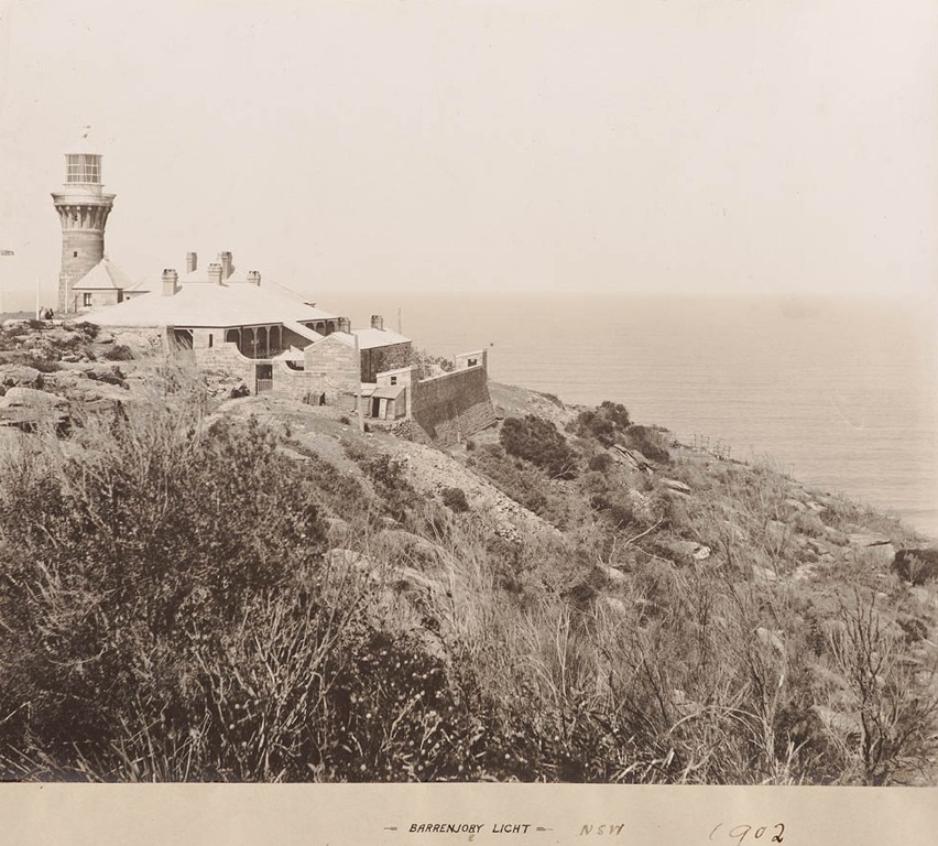
Searcy albums : Lighthouses in New South Wales, 1902, by Alfred Searcy, Barrenjoey Light, N.S.W., 1902 Digital Order No. a154002, courtesy State Library of NSW.
Barrenjoey Headland Lessees threads collected by A J Guesdon, 2013.
|
|
Further: Barrenjoey Headland
Ah Me-The Beauties Of Nature! By JUDY TUDOR January 13, 1945
Albert Thomas Black - History
Barrenjoey Headland - Amendments Alarming Community
Barrenjoey Headland Bushfire - Pictorial Update - Phoenix Landscape arises
Barrenjoey Commercialisation Canned by NSW Heritage and Environment Minister - Issue 123
Barrenjoey Headland - Bushflowers Spring 2012
Barrenjoey Headland Old and New Pictorial
Barrenjoey Headland Thriving After Bushfires - On Friday Environment Minister Rob Stokes announced more than $3 million over four years to restore the historic Barrenjoey Lighthouse and revitalise the Barrenjoey Headland heritage precinct. Friday was also the day the NSW Environment Minister announced the adoption of the amendment to Ku-ring-gai Chase National Park and Lion Island, Long Island and Spectacle Island Nature Reserves Plan of Management.
Barrenjoey Headland - The Lessees - History
Barrenjoey Lighthouse - The Construction - History
Barrenjoey Lighthouse Walk by Geoff Clarke
Barrenjoey Light Keepers - History
Barrenjoey Rally Against Proposed Ammendments to Plan of Management and Commercialisation of Barrenjoey Headland - For the Record
Barrenjoey Rally Pictorial Issue 120
Bi-Centenary Commemoration of Governor Phillip Honoured In Pittwater - Barrenjoey Repairs and Renovations Announced
Broken Bay Customs Station At Barrenjoey - History
The Barrenjoey School 1872 to 1894 - History
Front Page Issue 188 - Barrenjoey Rejuvenation continues
Front Page Issue 196 - Barrenjoey Lighthouse Rejuventaions 1.1.2015 - A stroll Around the Headland + First Few Days in Pittwater 2015 Pictorial
Governor Phillip's Barrenjoey Cairn - History
International Lighthouse Lightship Weekend 2013 at Barrenjoey
Palm Beach Golf Course - History
The Red Light Of Palm Beach by Jervis Sparks
Woodley's Cottage - History
Jervis Sparks - Profile
John Black - Profile
George Mulhall - First Lightkeeper at Barrenjoey and First Rowing Champion of Australia - History